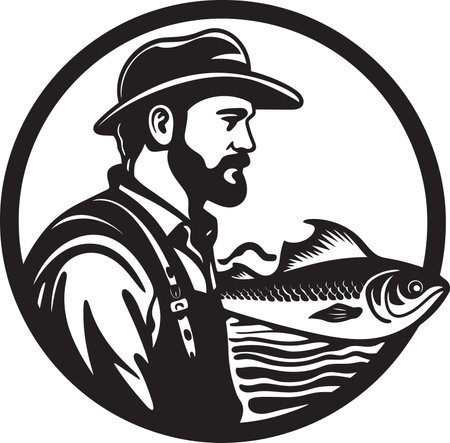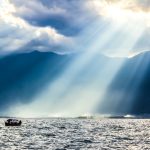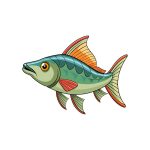1. Introduction to Backcountry Fly Fishing
There’s something truly special about casting a fly line in the middle of nowhere, surrounded by nothing but towering pines, snow-capped peaks, and the whisper of a mountain stream. Backcountry fly fishing is more than just a hobby—it’s an adventure that combines solitude, skill, and a deep connection with nature.
What Makes Backcountry Fly Fishing Unique?
Unlike fishing spots near towns or along highways, backcountry waters require effort to reach. That might mean hiking miles into the wilderness or even packing in on horseback. But for those willing to put in the work, the rewards are huge: crystal-clear waters, wild trout untouched by heavy angling pressure, and the kind of peace you just can’t find anywhere else.
Backcountry vs. Accessible Waters
| Feature | Backcountry Fishing | Accessible Fishing |
|---|---|---|
| Location | Remote mountain streams and alpine lakes | Roadside rivers, public parks, stocked ponds |
| Accessibility | Requires hiking or backpacking | Easily reachable by car or short walk |
| Fishing Pressure | Low—few anglers venture this far | High—popular and often crowded spots |
| Fish Behavior | More aggressive and less wary of flies | Cautious due to frequent exposure to anglers |
Why the Rocky Mountains Are a Fly Fishing Dream
The Rockies stretch from New Mexico all the way up into Canada, offering some of the best fly fishing terrain in North America. High-elevation lakes and streams teem with native cutthroat trout, brookies, rainbows, and browns. Many of these waters are tucked away in national forests and wilderness areas, giving anglers a true off-the-grid experience.
Top Reasons Anglers Love the Rockies:
- Diverse habitats: From alpine lakes to freestone creeks.
- Wild fish populations: Less stocking means more natural behavior.
- Breathtaking scenery: Fishing with a view doesn’t get better than this.
- Adventure factor: Reaching these spots is half the fun.
The Right Mindset for the Backcountry
If youre used to parking near a river and casting within minutes, backcountry fly fishing will challenge you in new ways. It requires planning, physical endurance, and respect for the environment—but it also brings unmatched reward. Whether youre looking for solitude or just want to chase wild trout where few others go, the Rocky Mountain backcountry offers an unforgettable journey into the heart of nature.
2. Essential Gear for the Wilderness
When youre heading deep into the Rocky Mountain backcountry for fly fishing, packing smart is everything. You want to stay light without giving up performance. Whether youre hiking in for a day or backpacking for several, having the right gear can make or break your trip.
Lightweight Fly Rods
For backcountry fishing, weight matters. Go with a 4-piece or even a 6-piece travel rod that easily fits in your pack. Look for rods in the 3-5 weight range—perfect for small streams and alpine lakes where trout are spooky but aggressive.
Recommended Features:
- Carbon fiber construction for lightness and sensitivity
- Protective rod tube for rugged trails
- Fast action tip for better casting distance in tight spots
Packable Waders and Boots
You don’t want to haul bulky waders up a mountain. Choose lightweight, breathable chest waders that roll up tight. Pair them with collapsible wading boots that offer good grip and ankle support without the extra pounds.
| Item | Recommended Feature |
|---|---|
| Waders | Packed size under 12 inches, less than 2 lbs, breathable material |
| Wading Boots | Cushioned soles, foldable design, rubber traction soles |
Multi-Use Tools
You don’t need to bring your whole fly tying bench into the wild. Instead, focus on compact tools that serve multiple purposes:
- Nippers with built-in hook eye cleaner: Save space and weight
- Zinger tool retractor: Keeps essentials like forceps or clippers handy
- Knot-tying tool combo: Helps tie secure knots fast when hands are cold or wet
Packing Smart: Tips & Tricks
The key to efficient backcountry fishing is minimalism. Here are a few tips to help you pack smarter:
- Create a gear checklist: Stick to the essentials based on your destination and duration.
- Select versatile flies: Patterns like Elk Hair Caddis, Parachute Adams, and Woolly Buggers cover most trout scenarios.
- Toss in backups: Bring an extra leader, tippet spool, and a few emergency flies just in case.
A well-packed kit lets you move faster, fish longer, and enjoy the solitude of those remote alpine waters without being weighed down.

3. Reading the Water in Untouched Terrain
When youre deep in the Rocky Mountain backcountry, far from crowded fishing spots and noisy roads, the water runs wild and undisturbed. This kind of untouched terrain offers a unique challenge—and reward—for fly anglers. Learning to read these remote waters is key to finding trout that rarely see a fly.
Understanding Wilderness Water
Backcountry streams and alpine lakes are shaped by nature alone. Without dams, development, or heavy fishing pressure, fish behavior and water dynamics follow natural patterns. That means you need to pay close attention to subtle signs in the water to locate fish.
Spotting Promising Fishing Spots
Whether youre approaching a high-mountain lake or a winding mountain stream, start by looking for classic fish-holding structures. These can include:
| Structure | Why It Matters |
|---|---|
| Pocket Water | Small pools behind rocks where trout rest out of the current while watching for food. |
| Undercut Banks | Provide cover and ambush spots for larger fish. |
| Inlets & Outlets (Lakes) | Moving water brings oxygen and food—often hotspots for feeding fish. |
| Drop-offs (Lakes) | Fish cruise along depth changes searching for meals. |
Interpreting Fish Behavior
In untouched areas, trout tend to be less spooky but still alert. Watch for:
- Rises: If you see rings on the surface, chances are good trout are feeding on insects.
- Slicks near structure: Slight disturbances in calm water near rocks or logs may signal a fish holding just below the surface.
- Shadow movement: On clear days, spotting shadows darting through shallow runs can lead you right to active fish.
The Role of Hydrodynamics
Water movement affects where fish hold and feed. In fast-moving mountain streams, look for areas where current slows down—like eddies or behind boulders—where trout conserve energy while watching for drifting insects. In lakes, wind direction can push food toward certain shorelines, creating natural feeding lanes.
Quick Tip:
If you’re unsure where to cast, follow the foam lines on the surface—they often trace the main current path where food naturally drifts.
By learning how to read untouched water like a local guide, youll greatly increase your chances of connecting with wild trout in one of North Americas most pristine fly fishing regions.
4. Flies That Work in High Country Waters
When youre miles deep into the Rocky Mountain backcountry with only what you can carry on your back, every fly in your box needs to earn its place. The high-altitude streams and alpine lakes of the Rockies are home to native cutthroat, brookies, rainbows, and browns—each with their own feeding habits that shift with the seasons. Knowing which flies work best—and when—is key to turning a hike into a trophy catch.
Understanding Seasonal Hatches in the Rockies
The Rockies have a short but intense fishing season due to snowpack and elevation. Matching the hatch is essential. Heres a breakdown of common hatches and the flies that mimic them effectively:
| Season | Common Hatches | Effective Fly Patterns |
|---|---|---|
| Spring (May–June) | Blue-winged Olives, Midges, Stoneflies | BWO Parachute, Zebra Midge, Yellow Sally |
| Summer (July–August) | Caddisflies, PMDs, Terrestrials (ants, beetles) | Elk Hair Caddis, Parachute Adams, Foam Beetle |
| Fall (September–October) | Mahogany Duns, October Caddis, Streamers for pre-spawn browns | Rusty Spinner, Orange Stimulator, Woolly Bugger |
Tie Smart: Minimalist Flies for Maximum Impact
Backcountry anglers live by the rule: pack light, fish smart. Instead of carrying dozens of different patterns, opt for versatile flies that imitate multiple insects or stages of life cycles. Dry-dropper rigs are especially effective and save space.
Top 5 Must-Have Backcountry Flies
- Parachute Adams (#14–18): Imitates mayflies and midges—works almost year-round.
- Zebra Midge (#18–22): Deadly during early season and cold water conditions.
- Hopper/Dropper Combo: Use a foam grasshopper on top with a beadhead nymph below.
- Elk Hair Caddis (#14–16): Floats well and triggers aggressive strikes in summer evenings.
- Woolly Bugger (#8–12): A classic streamer that mimics baitfish and leeches—great for larger trout in alpine lakes.
Tying Tip:
If youre tying your own flies before heading out, use lightweight materials like CDC (Cul de Canard) and foam. They’re buoyant and take up less space in your fly box. Stick with neutral colors—olive, black, tan—that cover a wide range of insect types found in the Rockies.
The key to success in high country waters is flexibility. Observe what’s flying around or floating downstream. Match it with one of your trusted patterns and let the wild do the rest.
5. Staying Safe and Leaving No Trace
Exploring the backcountry of the Rocky Mountains for fly fishing is an unforgettable experience, but it also comes with responsibility. Whether you’re trekking deep into alpine valleys or casting along remote mountain streams, staying safe and minimizing your impact on the environment are top priorities.
Backcountry Safety Essentials
Before heading out, make sure youre well-prepared for the unique challenges of the Rockies. Heres a quick guide to help you plan:
| Safety Aspect | What You Should Do |
|---|---|
| Bear Awareness | Carry bear spray and know how to use it. Store food in bear-proof containers and hang them when necessary. Make noise while hiking to avoid surprise encounters. |
| Navigation | Always carry a map, compass, and GPS device. Don’t rely solely on your phone—batteries die fast in cold or remote areas. |
| Weather Planning | The weather in the mountains changes quickly. Check forecasts before your trip and be ready for sudden storms or temperature drops. |
| First Aid | Bring a first aid kit and know basic wilderness first aid skills. Cuts, sprains, and blisters are common in rugged terrain. |
| Communication | A satellite messenger or emergency beacon can be a lifesaver. Don’t assume you’ll have cell service in the backcountry. |
Leave No Trace Principles for Anglers
The ecosystems of the Rocky Mountains are fragile and easily disrupted. Practicing Leave No Trace is key to preserving these wild places for future generations—and fish populations too.
Packing It In and Out
Everything you bring should come back with you—trash, leftover food, tippet clippings, even biodegradable items like orange peels can take years to decompose at high elevations.
Respect Wildlife and Other Anglers
Observe animals from a distance and never feed them. Give other anglers space on the water; solitude is part of why we venture into the backcountry in the first place.
Tread Lightly on Fragile Terrain
Stick to established trails when hiking and avoid trampling vegetation near stream banks. Wet boots can carry invasive species—clean your gear between trips.
Ethical Angling Practices
Catch and Release Done Right
If youre practicing catch-and-release, do it responsibly: use barbless hooks, handle fish gently with wet hands, keep them in the water as much as possible, and release them quickly.
Know Local Regulations
The rules can vary depending on where youre fishing—some alpine lakes may be catch-and-release only or have seasonal closures to protect spawning fish. Always check state wildlife agency guidelines before heading out.
Support Conservation Efforts
Consider donating to or volunteering with local conservation groups that maintain trails, monitor fish populations, and protect watersheds throughout the Rockies.
Treat every trip into the backcountry as both an adventure and a commitment—to safety, to nature, and to future generations of anglers who will cast their lines into these same wild waters.
6. Stories from the Trail: Real Angler Experiences
There’s something magical about standing knee-deep in a cold mountain stream, miles away from the nearest road. For many seasoned fly fishers, heading into the Rocky Mountain backcountry isn’t just about catching trout—it’s about reconnecting with nature, finding peace, and learning lessons that only wild places can teach. In this section, we’re sharing real stories from experienced anglers who’ve ventured deep into the Rockies, each offering a glimpse into the physical challenges and spiritual rewards of off-the-grid fly fishing.
The Healing Power of Solitude
Jake Thompson, a retired firefighter from Colorado Springs, found solace in the high-altitude streams of the San Juan Mountains after a tough year. “I hiked in alone for three days,” he recalls. “No cell service, no noise—just me and the river. I didn’t talk to anyone for almost a week, and it healed something in me.” Jake says that even though he caught fewer fish than usual, the trip helped him process grief and gain clarity.
Lessons Learned from Mother Nature
Samantha Lee, a guide based out of Bozeman, Montana, shared a humbling experience near Glacier National Park. “We were two days into the trail when a sudden storm rolled in,” she says. “The temperature dropped 30 degrees in hours. We had to set up camp fast and wait it out.” The next morning brought clear skies—and some of the best dry-fly action she’d ever seen. “Nature doesn’t care about your schedule,” Samantha laughs. “But if you respect her rhythms, she’ll reward you.”
Unexpected Connections
Fly fishing solo doesn’t always mean being alone. Michael Reyes from Denver met his now-best friend during a chance encounter on the trail to Maroon Bells Wilderness. “We were both hiking up to Crater Lake with rods sticking out of our packs,” he says. “We ended up sharing a fire, gear tips, and eventually planning trips together every summer.” Their bond formed over shared casts and campfire stories continues to this day.
Top Lessons Shared by Backcountry Anglers
| Lesson | Angler Insight |
|---|---|
| Always be prepared for weather changes | “Pack layers—even if its sunny when you start out.” – Samantha Lee |
| Solitude can be restorative | “Sometimes silence is what you need most.” – Jake Thompson |
| Be open to new friendships | “A shared love for fishing breaks down walls fast.” – Michael Reyes |
| Respect natures pace | “Let go of your agenda; follow natures lead.” – Samantha Lee |
The Rewards Beyond the Catch
The common thread in all these stories? The realization that fly fishing deep in the Rockies offers more than just trophy trout. It offers perspective. Whether its through solitude, overcoming unexpected challenges, or forging new friendships, these adventures remind us why we venture off-grid with rod in hand—because sometimes the best catches aren’t fish at all.


